Value Creation in Organisations: Operations, Marketing Analysis Report
VerifiedAdded on 2021/02/21
|16
|5280
|35
Report
AI Summary
This report provides a comprehensive analysis of value creation within an organization, specifically focusing on a case study of a frozen pea factory. It begins by outlining the main operations objectives, including customer service, transportation, control room functions, quality control, and packaging. The report then details the inputs and outputs of the transformation process, encompassing capital, resources, employees, machinery, and raw materials. The analysis further explores the type of process and layout used, along with an assessment of capacity levels at various stages of pea processing. A PESTEL analysis and a TOWS matrix are conducted to evaluate the external environment and strategic positioning. Finally, the report offers marketing recommendations based on the findings from the environmental analysis, providing a holistic view of the factory's operations and strategic direction.

Value Creation in
Organisations- Managing
Operations and Marketing
Organisations- Managing
Operations and Marketing
Paraphrase This Document
Need a fresh take? Get an instant paraphrase of this document with our AI Paraphraser

Table of Contents
INTRODUCTION...........................................................................................................................3
MAIN BODY...................................................................................................................................3
1. Discuss in detail the main operations objectives and the inputs and outputs of the
transformation process described in this case........................................................................3
2. Discuss the type of process and the layout used in this case. Considering the factors that
determine capacity levels, discuss different types of capacity and calculate capacities at each
main stage of pea processing..................................................................................................6
3. Conduct a PESTEL analysis & TOWS Matrix..................................................................7
4. Marketing recommendations based on finding................................................................11
CONCLUSION..............................................................................................................................13
REFERENCES..............................................................................................................................15
INTRODUCTION...........................................................................................................................3
MAIN BODY...................................................................................................................................3
1. Discuss in detail the main operations objectives and the inputs and outputs of the
transformation process described in this case........................................................................3
2. Discuss the type of process and the layout used in this case. Considering the factors that
determine capacity levels, discuss different types of capacity and calculate capacities at each
main stage of pea processing..................................................................................................6
3. Conduct a PESTEL analysis & TOWS Matrix..................................................................7
4. Marketing recommendations based on finding................................................................11
CONCLUSION..............................................................................................................................13
REFERENCES..............................................................................................................................15
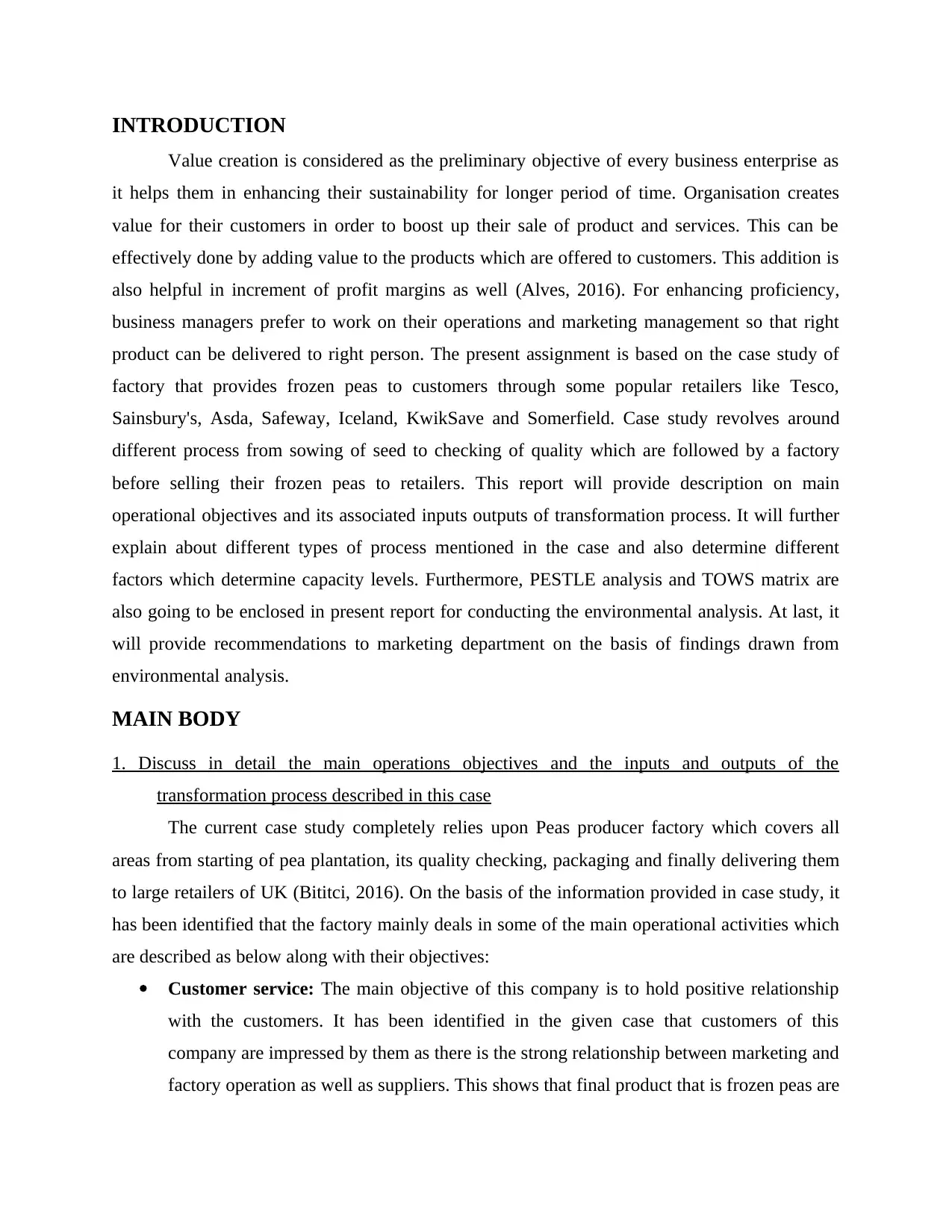
INTRODUCTION
Value creation is considered as the preliminary objective of every business enterprise as
it helps them in enhancing their sustainability for longer period of time. Organisation creates
value for their customers in order to boost up their sale of product and services. This can be
effectively done by adding value to the products which are offered to customers. This addition is
also helpful in increment of profit margins as well (Alves, 2016). For enhancing proficiency,
business managers prefer to work on their operations and marketing management so that right
product can be delivered to right person. The present assignment is based on the case study of
factory that provides frozen peas to customers through some popular retailers like Tesco,
Sainsbury's, Asda, Safeway, Iceland, KwikSave and Somerfield. Case study revolves around
different process from sowing of seed to checking of quality which are followed by a factory
before selling their frozen peas to retailers. This report will provide description on main
operational objectives and its associated inputs outputs of transformation process. It will further
explain about different types of process mentioned in the case and also determine different
factors which determine capacity levels. Furthermore, PESTLE analysis and TOWS matrix are
also going to be enclosed in present report for conducting the environmental analysis. At last, it
will provide recommendations to marketing department on the basis of findings drawn from
environmental analysis.
MAIN BODY
1. Discuss in detail the main operations objectives and the inputs and outputs of the
transformation process described in this case
The current case study completely relies upon Peas producer factory which covers all
areas from starting of pea plantation, its quality checking, packaging and finally delivering them
to large retailers of UK (Bititci, 2016). On the basis of the information provided in case study, it
has been identified that the factory mainly deals in some of the main operational activities which
are described as below along with their objectives:
Customer service: The main objective of this company is to hold positive relationship
with the customers. It has been identified in the given case that customers of this
company are impressed by them as there is the strong relationship between marketing and
factory operation as well as suppliers. This shows that final product that is frozen peas are
Value creation is considered as the preliminary objective of every business enterprise as
it helps them in enhancing their sustainability for longer period of time. Organisation creates
value for their customers in order to boost up their sale of product and services. This can be
effectively done by adding value to the products which are offered to customers. This addition is
also helpful in increment of profit margins as well (Alves, 2016). For enhancing proficiency,
business managers prefer to work on their operations and marketing management so that right
product can be delivered to right person. The present assignment is based on the case study of
factory that provides frozen peas to customers through some popular retailers like Tesco,
Sainsbury's, Asda, Safeway, Iceland, KwikSave and Somerfield. Case study revolves around
different process from sowing of seed to checking of quality which are followed by a factory
before selling their frozen peas to retailers. This report will provide description on main
operational objectives and its associated inputs outputs of transformation process. It will further
explain about different types of process mentioned in the case and also determine different
factors which determine capacity levels. Furthermore, PESTLE analysis and TOWS matrix are
also going to be enclosed in present report for conducting the environmental analysis. At last, it
will provide recommendations to marketing department on the basis of findings drawn from
environmental analysis.
MAIN BODY
1. Discuss in detail the main operations objectives and the inputs and outputs of the
transformation process described in this case
The current case study completely relies upon Peas producer factory which covers all
areas from starting of pea plantation, its quality checking, packaging and finally delivering them
to large retailers of UK (Bititci, 2016). On the basis of the information provided in case study, it
has been identified that the factory mainly deals in some of the main operational activities which
are described as below along with their objectives:
Customer service: The main objective of this company is to hold positive relationship
with the customers. It has been identified in the given case that customers of this
company are impressed by them as there is the strong relationship between marketing and
factory operation as well as suppliers. This shows that final product that is frozen peas are
⊘ This is a preview!⊘
Do you want full access?
Subscribe today to unlock all pages.

Trusted by 1+ million students worldwide
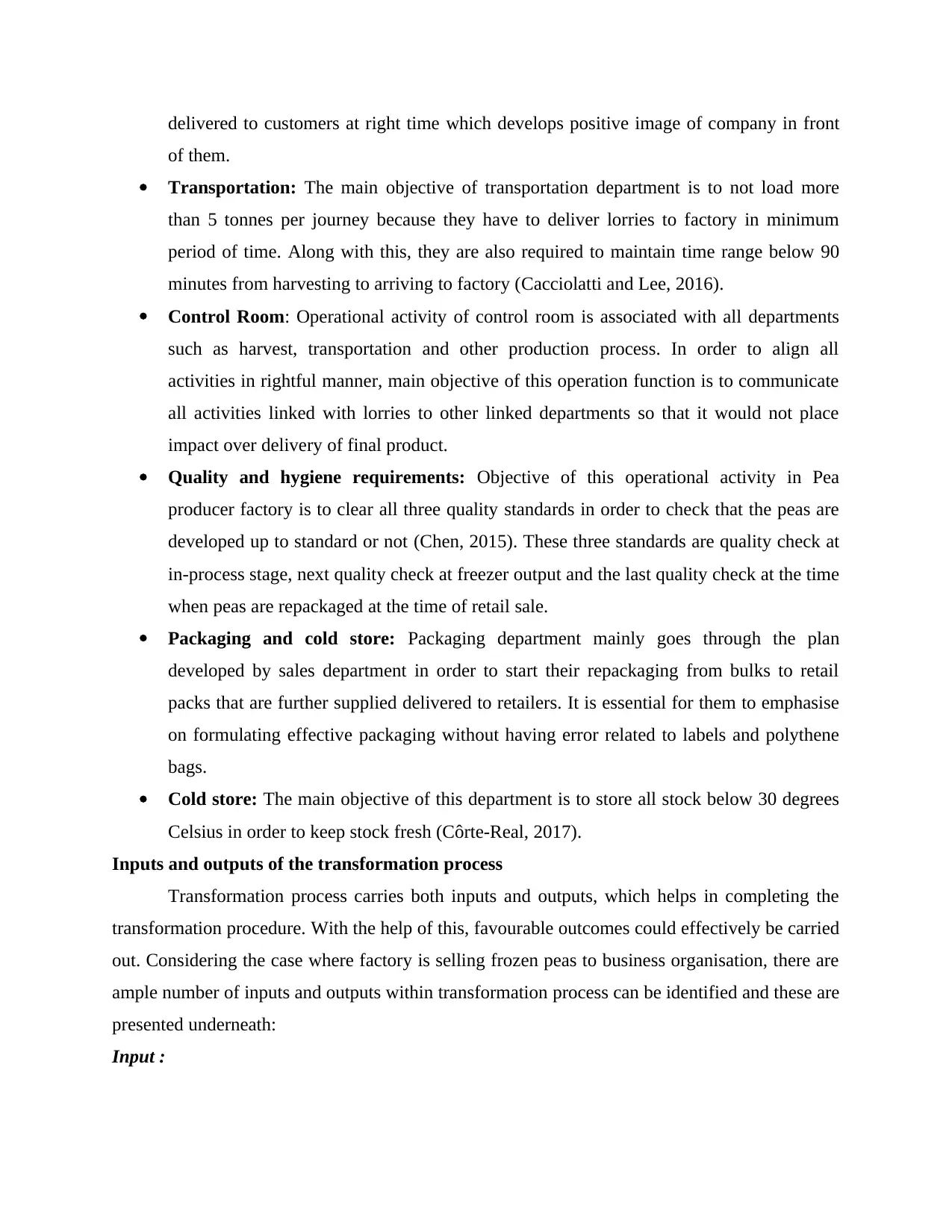
delivered to customers at right time which develops positive image of company in front
of them.
Transportation: The main objective of transportation department is to not load more
than 5 tonnes per journey because they have to deliver lorries to factory in minimum
period of time. Along with this, they are also required to maintain time range below 90
minutes from harvesting to arriving to factory (Cacciolatti and Lee, 2016).
Control Room: Operational activity of control room is associated with all departments
such as harvest, transportation and other production process. In order to align all
activities in rightful manner, main objective of this operation function is to communicate
all activities linked with lorries to other linked departments so that it would not place
impact over delivery of final product.
Quality and hygiene requirements: Objective of this operational activity in Pea
producer factory is to clear all three quality standards in order to check that the peas are
developed up to standard or not (Chen, 2015). These three standards are quality check at
in-process stage, next quality check at freezer output and the last quality check at the time
when peas are repackaged at the time of retail sale.
Packaging and cold store: Packaging department mainly goes through the plan
developed by sales department in order to start their repackaging from bulks to retail
packs that are further supplied delivered to retailers. It is essential for them to emphasise
on formulating effective packaging without having error related to labels and polythene
bags.
Cold store: The main objective of this department is to store all stock below 30 degrees
Celsius in order to keep stock fresh (Côrte-Real, 2017).
Inputs and outputs of the transformation process
Transformation process carries both inputs and outputs, which helps in completing the
transformation procedure. With the help of this, favourable outcomes could effectively be carried
out. Considering the case where factory is selling frozen peas to business organisation, there are
ample number of inputs and outputs within transformation process can be identified and these are
presented underneath:
Input :
of them.
Transportation: The main objective of transportation department is to not load more
than 5 tonnes per journey because they have to deliver lorries to factory in minimum
period of time. Along with this, they are also required to maintain time range below 90
minutes from harvesting to arriving to factory (Cacciolatti and Lee, 2016).
Control Room: Operational activity of control room is associated with all departments
such as harvest, transportation and other production process. In order to align all
activities in rightful manner, main objective of this operation function is to communicate
all activities linked with lorries to other linked departments so that it would not place
impact over delivery of final product.
Quality and hygiene requirements: Objective of this operational activity in Pea
producer factory is to clear all three quality standards in order to check that the peas are
developed up to standard or not (Chen, 2015). These three standards are quality check at
in-process stage, next quality check at freezer output and the last quality check at the time
when peas are repackaged at the time of retail sale.
Packaging and cold store: Packaging department mainly goes through the plan
developed by sales department in order to start their repackaging from bulks to retail
packs that are further supplied delivered to retailers. It is essential for them to emphasise
on formulating effective packaging without having error related to labels and polythene
bags.
Cold store: The main objective of this department is to store all stock below 30 degrees
Celsius in order to keep stock fresh (Côrte-Real, 2017).
Inputs and outputs of the transformation process
Transformation process carries both inputs and outputs, which helps in completing the
transformation procedure. With the help of this, favourable outcomes could effectively be carried
out. Considering the case where factory is selling frozen peas to business organisation, there are
ample number of inputs and outputs within transformation process can be identified and these are
presented underneath:
Input :
Paraphrase This Document
Need a fresh take? Get an instant paraphrase of this document with our AI Paraphraser
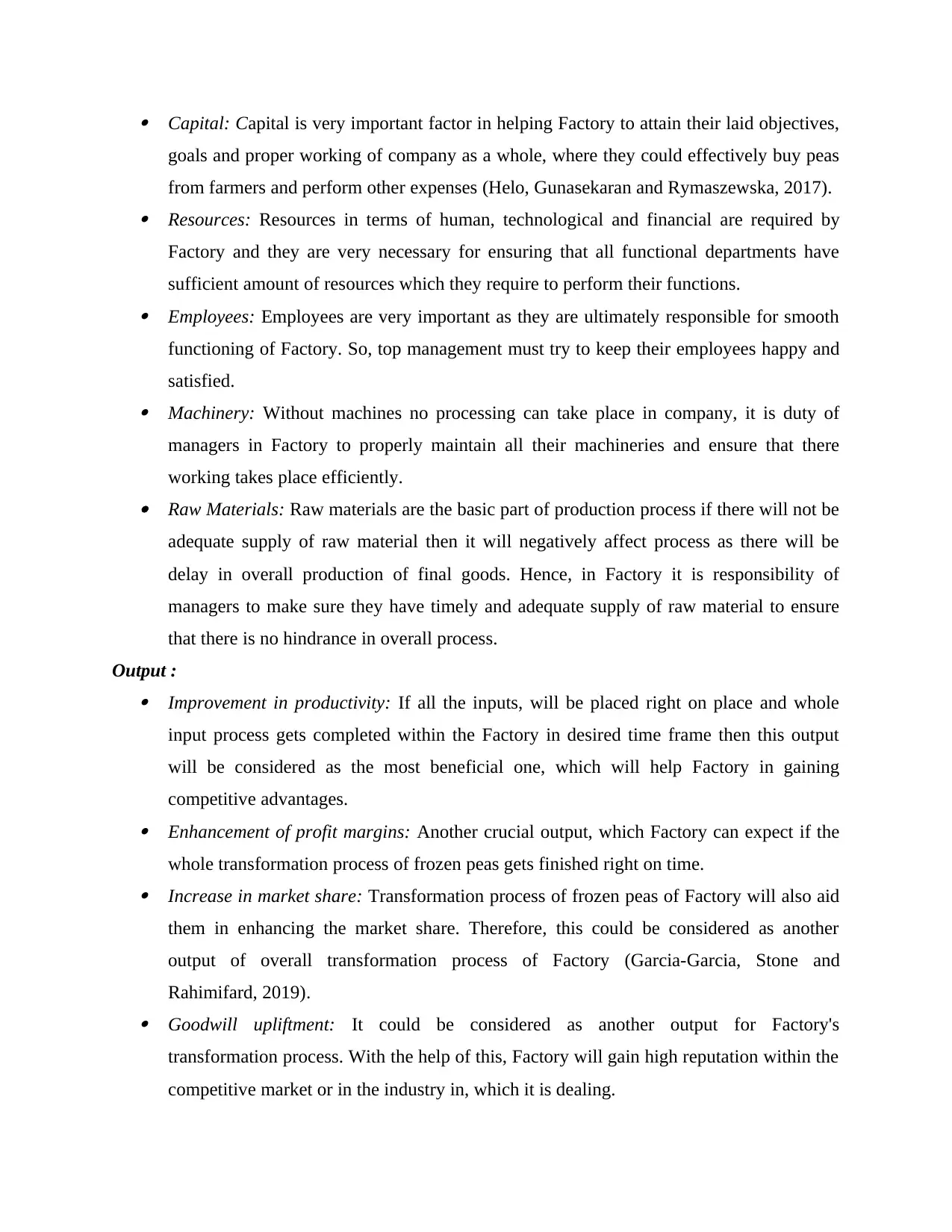
Capital: Capital is very important factor in helping Factory to attain their laid objectives,
goals and proper working of company as a whole, where they could effectively buy peas
from farmers and perform other expenses (Helo, Gunasekaran and Rymaszewska, 2017). Resources: Resources in terms of human, technological and financial are required by
Factory and they are very necessary for ensuring that all functional departments have
sufficient amount of resources which they require to perform their functions. Employees: Employees are very important as they are ultimately responsible for smooth
functioning of Factory. So, top management must try to keep their employees happy and
satisfied. Machinery: Without machines no processing can take place in company, it is duty of
managers in Factory to properly maintain all their machineries and ensure that there
working takes place efficiently. Raw Materials: Raw materials are the basic part of production process if there will not be
adequate supply of raw material then it will negatively affect process as there will be
delay in overall production of final goods. Hence, in Factory it is responsibility of
managers to make sure they have timely and adequate supply of raw material to ensure
that there is no hindrance in overall process.
Output : Improvement in productivity: If all the inputs, will be placed right on place and whole
input process gets completed within the Factory in desired time frame then this output
will be considered as the most beneficial one, which will help Factory in gaining
competitive advantages. Enhancement of profit margins: Another crucial output, which Factory can expect if the
whole transformation process of frozen peas gets finished right on time. Increase in market share: Transformation process of frozen peas of Factory will also aid
them in enhancing the market share. Therefore, this could be considered as another
output of overall transformation process of Factory (Garcia-Garcia, Stone and
Rahimifard, 2019). Goodwill upliftment: It could be considered as another output for Factory's
transformation process. With the help of this, Factory will gain high reputation within the
competitive market or in the industry in, which it is dealing.
goals and proper working of company as a whole, where they could effectively buy peas
from farmers and perform other expenses (Helo, Gunasekaran and Rymaszewska, 2017). Resources: Resources in terms of human, technological and financial are required by
Factory and they are very necessary for ensuring that all functional departments have
sufficient amount of resources which they require to perform their functions. Employees: Employees are very important as they are ultimately responsible for smooth
functioning of Factory. So, top management must try to keep their employees happy and
satisfied. Machinery: Without machines no processing can take place in company, it is duty of
managers in Factory to properly maintain all their machineries and ensure that there
working takes place efficiently. Raw Materials: Raw materials are the basic part of production process if there will not be
adequate supply of raw material then it will negatively affect process as there will be
delay in overall production of final goods. Hence, in Factory it is responsibility of
managers to make sure they have timely and adequate supply of raw material to ensure
that there is no hindrance in overall process.
Output : Improvement in productivity: If all the inputs, will be placed right on place and whole
input process gets completed within the Factory in desired time frame then this output
will be considered as the most beneficial one, which will help Factory in gaining
competitive advantages. Enhancement of profit margins: Another crucial output, which Factory can expect if the
whole transformation process of frozen peas gets finished right on time. Increase in market share: Transformation process of frozen peas of Factory will also aid
them in enhancing the market share. Therefore, this could be considered as another
output of overall transformation process of Factory (Garcia-Garcia, Stone and
Rahimifard, 2019). Goodwill upliftment: It could be considered as another output for Factory's
transformation process. With the help of this, Factory will gain high reputation within the
competitive market or in the industry in, which it is dealing.
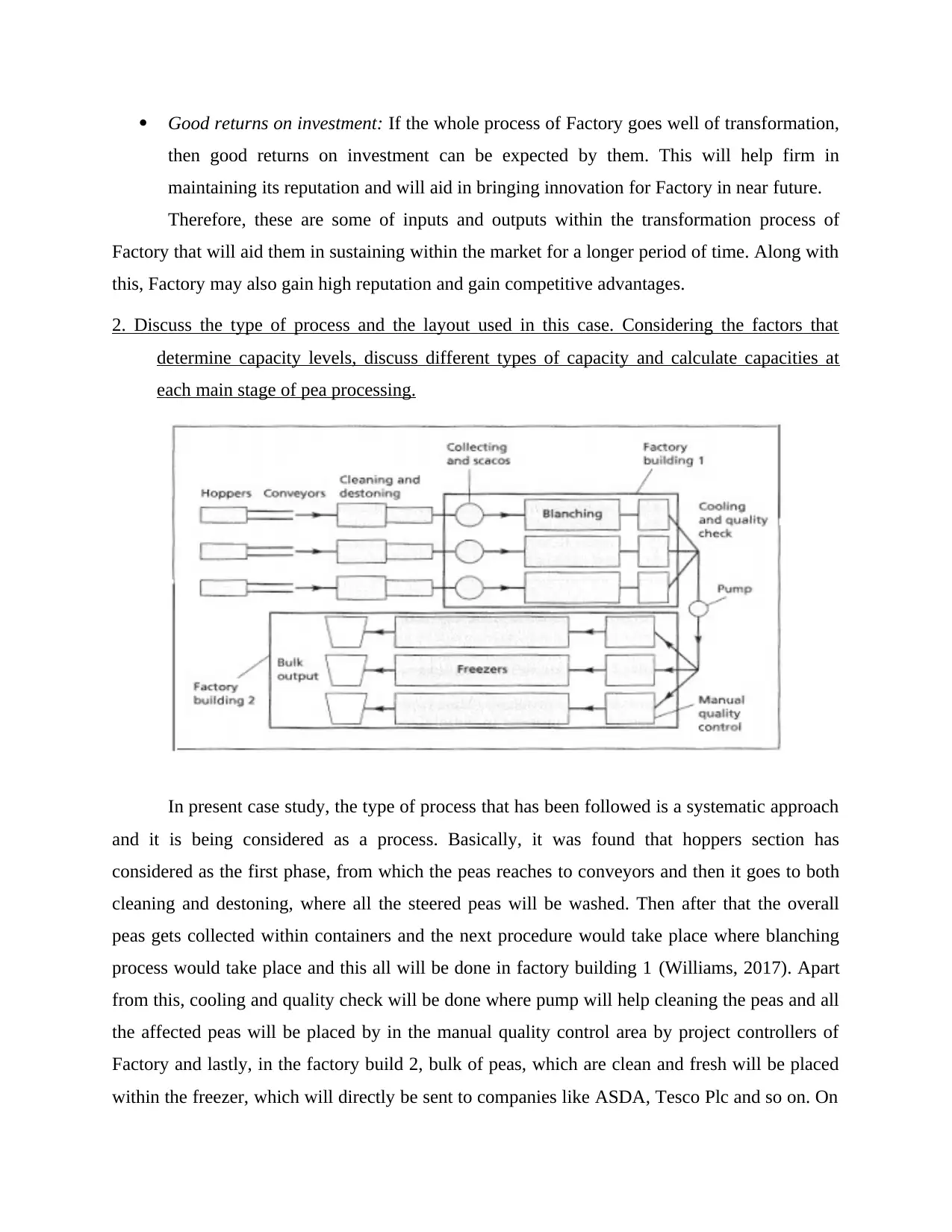
Good returns on investment: If the whole process of Factory goes well of transformation,
then good returns on investment can be expected by them. This will help firm in
maintaining its reputation and will aid in bringing innovation for Factory in near future.
Therefore, these are some of inputs and outputs within the transformation process of
Factory that will aid them in sustaining within the market for a longer period of time. Along with
this, Factory may also gain high reputation and gain competitive advantages.
2. Discuss the type of process and the layout used in this case. Considering the factors that
determine capacity levels, discuss different types of capacity and calculate capacities at
each main stage of pea processing.
In present case study, the type of process that has been followed is a systematic approach
and it is being considered as a process. Basically, it was found that hoppers section has
considered as the first phase, from which the peas reaches to conveyors and then it goes to both
cleaning and destoning, where all the steered peas will be washed. Then after that the overall
peas gets collected within containers and the next procedure would take place where blanching
process would take place and this all will be done in factory building 1 (Williams, 2017). Apart
from this, cooling and quality check will be done where pump will help cleaning the peas and all
the affected peas will be placed by in the manual quality control area by project controllers of
Factory and lastly, in the factory build 2, bulk of peas, which are clean and fresh will be placed
within the freezer, which will directly be sent to companies like ASDA, Tesco Plc and so on. On
then good returns on investment can be expected by them. This will help firm in
maintaining its reputation and will aid in bringing innovation for Factory in near future.
Therefore, these are some of inputs and outputs within the transformation process of
Factory that will aid them in sustaining within the market for a longer period of time. Along with
this, Factory may also gain high reputation and gain competitive advantages.
2. Discuss the type of process and the layout used in this case. Considering the factors that
determine capacity levels, discuss different types of capacity and calculate capacities at
each main stage of pea processing.
In present case study, the type of process that has been followed is a systematic approach
and it is being considered as a process. Basically, it was found that hoppers section has
considered as the first phase, from which the peas reaches to conveyors and then it goes to both
cleaning and destoning, where all the steered peas will be washed. Then after that the overall
peas gets collected within containers and the next procedure would take place where blanching
process would take place and this all will be done in factory building 1 (Williams, 2017). Apart
from this, cooling and quality check will be done where pump will help cleaning the peas and all
the affected peas will be placed by in the manual quality control area by project controllers of
Factory and lastly, in the factory build 2, bulk of peas, which are clean and fresh will be placed
within the freezer, which will directly be sent to companies like ASDA, Tesco Plc and so on. On
⊘ This is a preview!⊘
Do you want full access?
Subscribe today to unlock all pages.

Trusted by 1+ million students worldwide
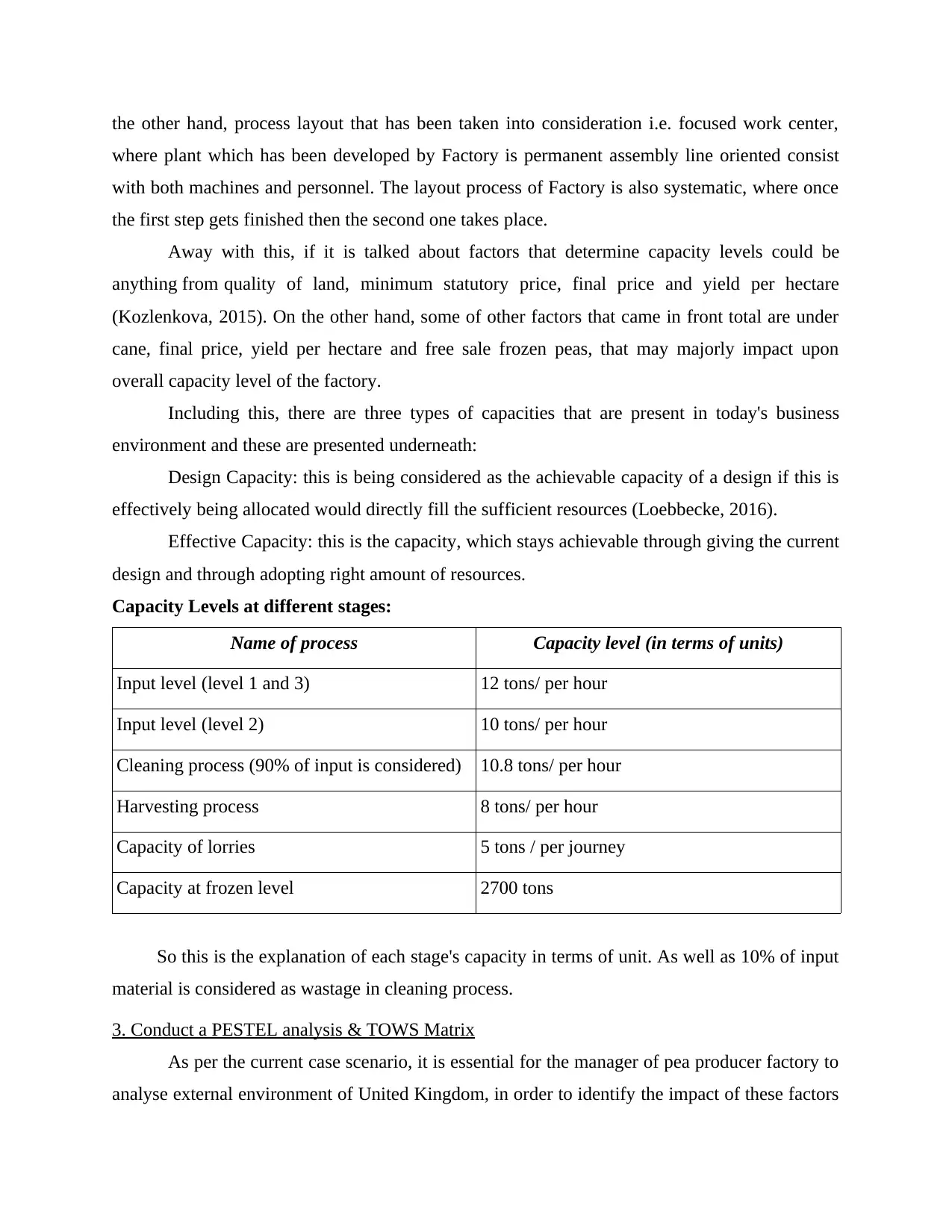
the other hand, process layout that has been taken into consideration i.e. focused work center,
where plant which has been developed by Factory is permanent assembly line oriented consist
with both machines and personnel. The layout process of Factory is also systematic, where once
the first step gets finished then the second one takes place.
Away with this, if it is talked about factors that determine capacity levels could be
anything from quality of land, minimum statutory price, final price and yield per hectare
(Kozlenkova, 2015). On the other hand, some of other factors that came in front total are under
cane, final price, yield per hectare and free sale frozen peas, that may majorly impact upon
overall capacity level of the factory.
Including this, there are three types of capacities that are present in today's business
environment and these are presented underneath:
Design Capacity: this is being considered as the achievable capacity of a design if this is
effectively being allocated would directly fill the sufficient resources (Loebbecke, 2016).
Effective Capacity: this is the capacity, which stays achievable through giving the current
design and through adopting right amount of resources.
Capacity Levels at different stages:
Name of process Capacity level (in terms of units)
Input level (level 1 and 3) 12 tons/ per hour
Input level (level 2) 10 tons/ per hour
Cleaning process (90% of input is considered) 10.8 tons/ per hour
Harvesting process 8 tons/ per hour
Capacity of lorries 5 tons / per journey
Capacity at frozen level 2700 tons
So this is the explanation of each stage's capacity in terms of unit. As well as 10% of input
material is considered as wastage in cleaning process.
3. Conduct a PESTEL analysis & TOWS Matrix
As per the current case scenario, it is essential for the manager of pea producer factory to
analyse external environment of United Kingdom, in order to identify the impact of these factors
where plant which has been developed by Factory is permanent assembly line oriented consist
with both machines and personnel. The layout process of Factory is also systematic, where once
the first step gets finished then the second one takes place.
Away with this, if it is talked about factors that determine capacity levels could be
anything from quality of land, minimum statutory price, final price and yield per hectare
(Kozlenkova, 2015). On the other hand, some of other factors that came in front total are under
cane, final price, yield per hectare and free sale frozen peas, that may majorly impact upon
overall capacity level of the factory.
Including this, there are three types of capacities that are present in today's business
environment and these are presented underneath:
Design Capacity: this is being considered as the achievable capacity of a design if this is
effectively being allocated would directly fill the sufficient resources (Loebbecke, 2016).
Effective Capacity: this is the capacity, which stays achievable through giving the current
design and through adopting right amount of resources.
Capacity Levels at different stages:
Name of process Capacity level (in terms of units)
Input level (level 1 and 3) 12 tons/ per hour
Input level (level 2) 10 tons/ per hour
Cleaning process (90% of input is considered) 10.8 tons/ per hour
Harvesting process 8 tons/ per hour
Capacity of lorries 5 tons / per journey
Capacity at frozen level 2700 tons
So this is the explanation of each stage's capacity in terms of unit. As well as 10% of input
material is considered as wastage in cleaning process.
3. Conduct a PESTEL analysis & TOWS Matrix
As per the current case scenario, it is essential for the manager of pea producer factory to
analyse external environment of United Kingdom, in order to identify the impact of these factors
Paraphrase This Document
Need a fresh take? Get an instant paraphrase of this document with our AI Paraphraser
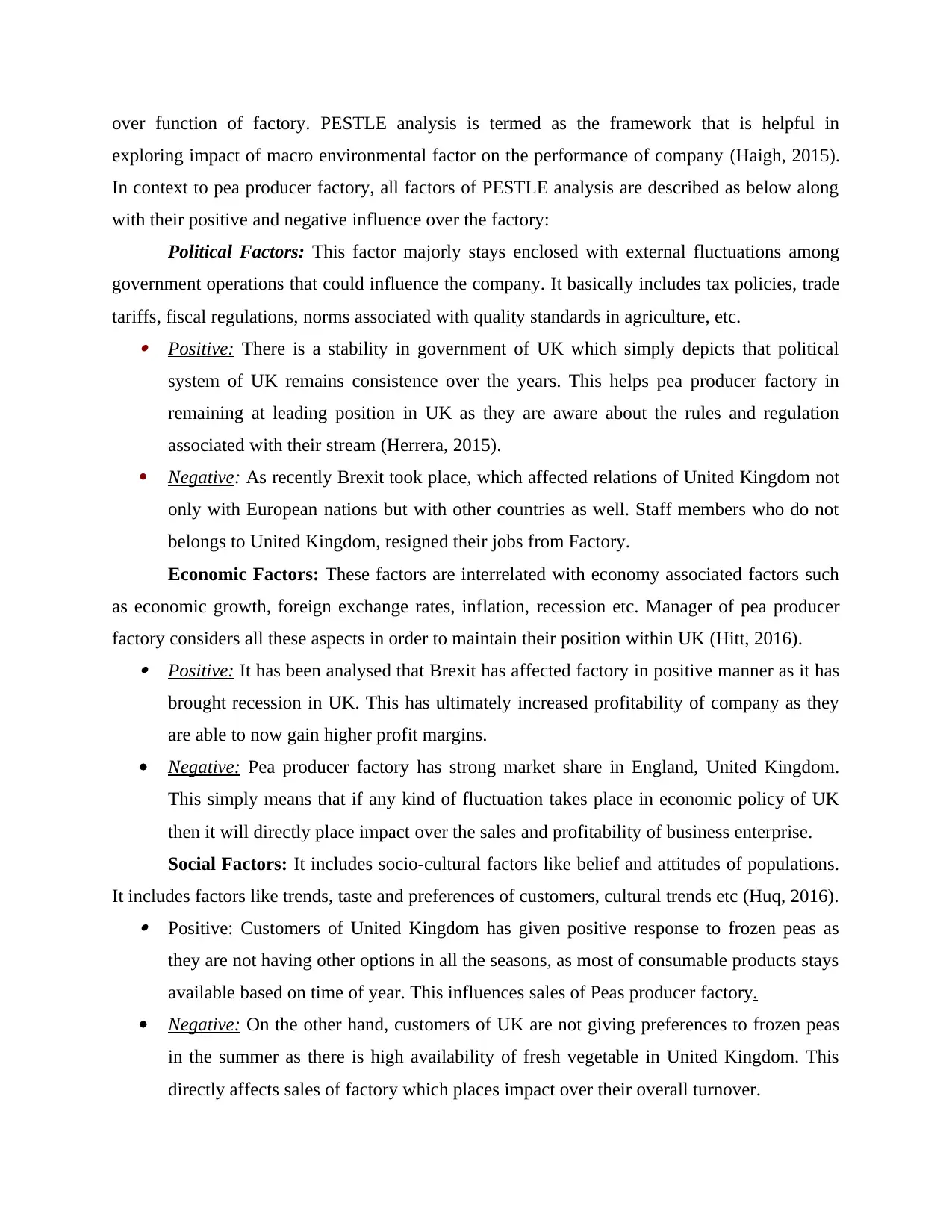
over function of factory. PESTLE analysis is termed as the framework that is helpful in
exploring impact of macro environmental factor on the performance of company (Haigh, 2015).
In context to pea producer factory, all factors of PESTLE analysis are described as below along
with their positive and negative influence over the factory:
Political Factors: This factor majorly stays enclosed with external fluctuations among
government operations that could influence the company. It basically includes tax policies, trade
tariffs, fiscal regulations, norms associated with quality standards in agriculture, etc. Positive: There is a stability in government of UK which simply depicts that political
system of UK remains consistence over the years. This helps pea producer factory in
remaining at leading position in UK as they are aware about the rules and regulation
associated with their stream (Herrera, 2015).
Negative: As recently Brexit took place, which affected relations of United Kingdom not
only with European nations but with other countries as well. Staff members who do not
belongs to United Kingdom, resigned their jobs from Factory.
Economic Factors: These factors are interrelated with economy associated factors such
as economic growth, foreign exchange rates, inflation, recession etc. Manager of pea producer
factory considers all these aspects in order to maintain their position within UK (Hitt, 2016). Positive: It has been analysed that Brexit has affected factory in positive manner as it has
brought recession in UK. This has ultimately increased profitability of company as they
are able to now gain higher profit margins.
Negative: Pea producer factory has strong market share in England, United Kingdom.
This simply means that if any kind of fluctuation takes place in economic policy of UK
then it will directly place impact over the sales and profitability of business enterprise.
Social Factors: It includes socio-cultural factors like belief and attitudes of populations.
It includes factors like trends, taste and preferences of customers, cultural trends etc (Huq, 2016). Positive: Customers of United Kingdom has given positive response to frozen peas as
they are not having other options in all the seasons, as most of consumable products stays
available based on time of year. This influences sales of Peas producer factory.
Negative: On the other hand, customers of UK are not giving preferences to frozen peas
in the summer as there is high availability of fresh vegetable in United Kingdom. This
directly affects sales of factory which places impact over their overall turnover.
exploring impact of macro environmental factor on the performance of company (Haigh, 2015).
In context to pea producer factory, all factors of PESTLE analysis are described as below along
with their positive and negative influence over the factory:
Political Factors: This factor majorly stays enclosed with external fluctuations among
government operations that could influence the company. It basically includes tax policies, trade
tariffs, fiscal regulations, norms associated with quality standards in agriculture, etc. Positive: There is a stability in government of UK which simply depicts that political
system of UK remains consistence over the years. This helps pea producer factory in
remaining at leading position in UK as they are aware about the rules and regulation
associated with their stream (Herrera, 2015).
Negative: As recently Brexit took place, which affected relations of United Kingdom not
only with European nations but with other countries as well. Staff members who do not
belongs to United Kingdom, resigned their jobs from Factory.
Economic Factors: These factors are interrelated with economy associated factors such
as economic growth, foreign exchange rates, inflation, recession etc. Manager of pea producer
factory considers all these aspects in order to maintain their position within UK (Hitt, 2016). Positive: It has been analysed that Brexit has affected factory in positive manner as it has
brought recession in UK. This has ultimately increased profitability of company as they
are able to now gain higher profit margins.
Negative: Pea producer factory has strong market share in England, United Kingdom.
This simply means that if any kind of fluctuation takes place in economic policy of UK
then it will directly place impact over the sales and profitability of business enterprise.
Social Factors: It includes socio-cultural factors like belief and attitudes of populations.
It includes factors like trends, taste and preferences of customers, cultural trends etc (Huq, 2016). Positive: Customers of United Kingdom has given positive response to frozen peas as
they are not having other options in all the seasons, as most of consumable products stays
available based on time of year. This influences sales of Peas producer factory.
Negative: On the other hand, customers of UK are not giving preferences to frozen peas
in the summer as there is high availability of fresh vegetable in United Kingdom. This
directly affects sales of factory which places impact over their overall turnover.
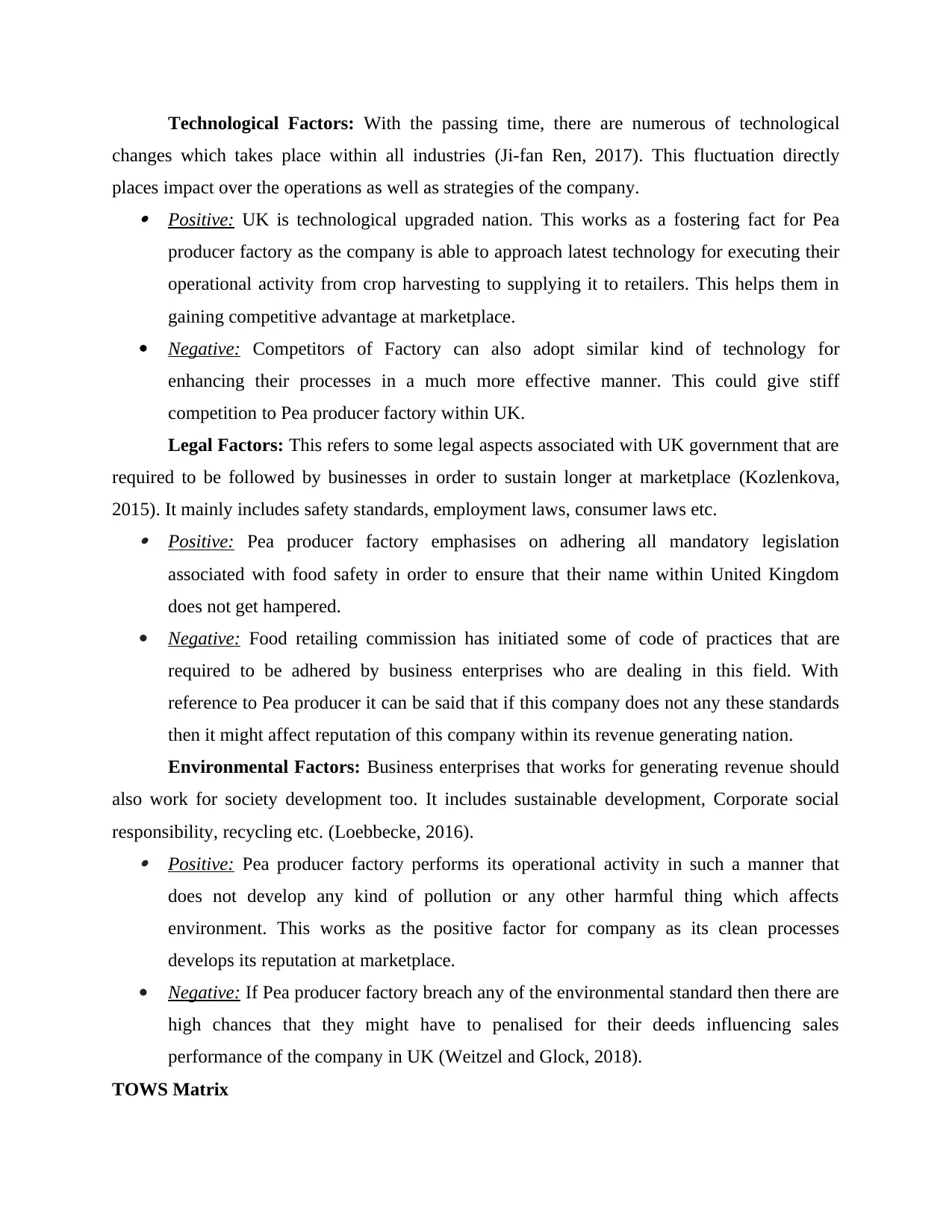
Technological Factors: With the passing time, there are numerous of technological
changes which takes place within all industries (Ji-fan Ren, 2017). This fluctuation directly
places impact over the operations as well as strategies of the company. Positive: UK is technological upgraded nation. This works as a fostering fact for Pea
producer factory as the company is able to approach latest technology for executing their
operational activity from crop harvesting to supplying it to retailers. This helps them in
gaining competitive advantage at marketplace.
Negative: Competitors of Factory can also adopt similar kind of technology for
enhancing their processes in a much more effective manner. This could give stiff
competition to Pea producer factory within UK.
Legal Factors: This refers to some legal aspects associated with UK government that are
required to be followed by businesses in order to sustain longer at marketplace (Kozlenkova,
2015). It mainly includes safety standards, employment laws, consumer laws etc. Positive: Pea producer factory emphasises on adhering all mandatory legislation
associated with food safety in order to ensure that their name within United Kingdom
does not get hampered.
Negative: Food retailing commission has initiated some of code of practices that are
required to be adhered by business enterprises who are dealing in this field. With
reference to Pea producer it can be said that if this company does not any these standards
then it might affect reputation of this company within its revenue generating nation.
Environmental Factors: Business enterprises that works for generating revenue should
also work for society development too. It includes sustainable development, Corporate social
responsibility, recycling etc. (Loebbecke, 2016). Positive: Pea producer factory performs its operational activity in such a manner that
does not develop any kind of pollution or any other harmful thing which affects
environment. This works as the positive factor for company as its clean processes
develops its reputation at marketplace.
Negative: If Pea producer factory breach any of the environmental standard then there are
high chances that they might have to penalised for their deeds influencing sales
performance of the company in UK (Weitzel and Glock, 2018).
TOWS Matrix
changes which takes place within all industries (Ji-fan Ren, 2017). This fluctuation directly
places impact over the operations as well as strategies of the company. Positive: UK is technological upgraded nation. This works as a fostering fact for Pea
producer factory as the company is able to approach latest technology for executing their
operational activity from crop harvesting to supplying it to retailers. This helps them in
gaining competitive advantage at marketplace.
Negative: Competitors of Factory can also adopt similar kind of technology for
enhancing their processes in a much more effective manner. This could give stiff
competition to Pea producer factory within UK.
Legal Factors: This refers to some legal aspects associated with UK government that are
required to be followed by businesses in order to sustain longer at marketplace (Kozlenkova,
2015). It mainly includes safety standards, employment laws, consumer laws etc. Positive: Pea producer factory emphasises on adhering all mandatory legislation
associated with food safety in order to ensure that their name within United Kingdom
does not get hampered.
Negative: Food retailing commission has initiated some of code of practices that are
required to be adhered by business enterprises who are dealing in this field. With
reference to Pea producer it can be said that if this company does not any these standards
then it might affect reputation of this company within its revenue generating nation.
Environmental Factors: Business enterprises that works for generating revenue should
also work for society development too. It includes sustainable development, Corporate social
responsibility, recycling etc. (Loebbecke, 2016). Positive: Pea producer factory performs its operational activity in such a manner that
does not develop any kind of pollution or any other harmful thing which affects
environment. This works as the positive factor for company as its clean processes
develops its reputation at marketplace.
Negative: If Pea producer factory breach any of the environmental standard then there are
high chances that they might have to penalised for their deeds influencing sales
performance of the company in UK (Weitzel and Glock, 2018).
TOWS Matrix
⊘ This is a preview!⊘
Do you want full access?
Subscribe today to unlock all pages.

Trusted by 1+ million students worldwide
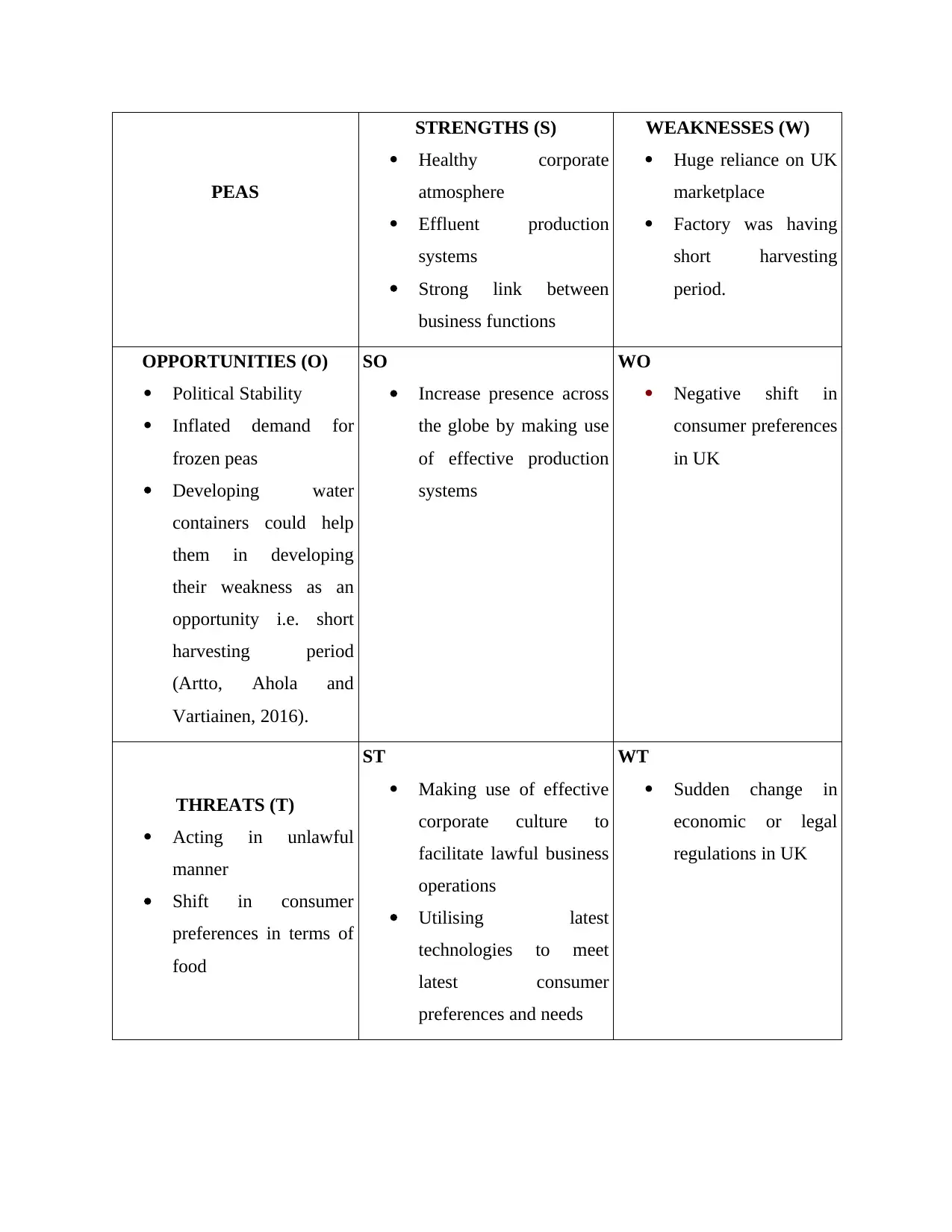
PEAS
STRENGTHS (S)
Healthy corporate
atmosphere
Effluent production
systems
Strong link between
business functions
WEAKNESSES (W)
Huge reliance on UK
marketplace
Factory was having
short harvesting
period.
OPPORTUNITIES (O)
Political Stability
Inflated demand for
frozen peas
Developing water
containers could help
them in developing
their weakness as an
opportunity i.e. short
harvesting period
(Artto, Ahola and
Vartiainen, 2016).
SO
Increase presence across
the globe by making use
of effective production
systems
WO
Negative shift in
consumer preferences
in UK
THREATS (T)
Acting in unlawful
manner
Shift in consumer
preferences in terms of
food
ST
Making use of effective
corporate culture to
facilitate lawful business
operations
Utilising latest
technologies to meet
latest consumer
preferences and needs
WT
Sudden change in
economic or legal
regulations in UK
STRENGTHS (S)
Healthy corporate
atmosphere
Effluent production
systems
Strong link between
business functions
WEAKNESSES (W)
Huge reliance on UK
marketplace
Factory was having
short harvesting
period.
OPPORTUNITIES (O)
Political Stability
Inflated demand for
frozen peas
Developing water
containers could help
them in developing
their weakness as an
opportunity i.e. short
harvesting period
(Artto, Ahola and
Vartiainen, 2016).
SO
Increase presence across
the globe by making use
of effective production
systems
WO
Negative shift in
consumer preferences
in UK
THREATS (T)
Acting in unlawful
manner
Shift in consumer
preferences in terms of
food
ST
Making use of effective
corporate culture to
facilitate lawful business
operations
Utilising latest
technologies to meet
latest consumer
preferences and needs
WT
Sudden change in
economic or legal
regulations in UK
Paraphrase This Document
Need a fresh take? Get an instant paraphrase of this document with our AI Paraphraser
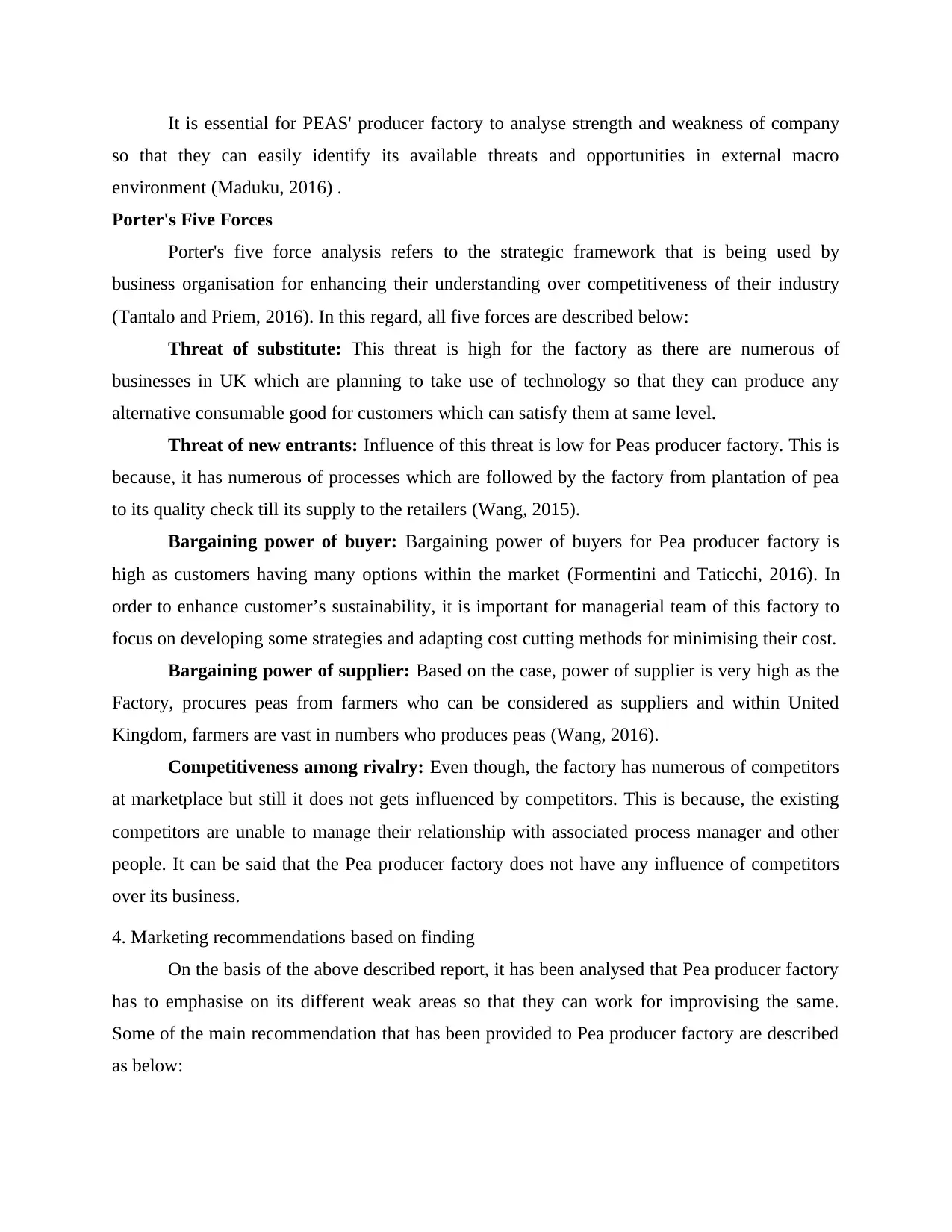
It is essential for PEAS' producer factory to analyse strength and weakness of company
so that they can easily identify its available threats and opportunities in external macro
environment (Maduku, 2016) .
Porter's Five Forces
Porter's five force analysis refers to the strategic framework that is being used by
business organisation for enhancing their understanding over competitiveness of their industry
(Tantalo and Priem, 2016). In this regard, all five forces are described below:
Threat of substitute: This threat is high for the factory as there are numerous of
businesses in UK which are planning to take use of technology so that they can produce any
alternative consumable good for customers which can satisfy them at same level.
Threat of new entrants: Influence of this threat is low for Peas producer factory. This is
because, it has numerous of processes which are followed by the factory from plantation of pea
to its quality check till its supply to the retailers (Wang, 2015).
Bargaining power of buyer: Bargaining power of buyers for Pea producer factory is
high as customers having many options within the market (Formentini and Taticchi, 2016). In
order to enhance customer’s sustainability, it is important for managerial team of this factory to
focus on developing some strategies and adapting cost cutting methods for minimising their cost.
Bargaining power of supplier: Based on the case, power of supplier is very high as the
Factory, procures peas from farmers who can be considered as suppliers and within United
Kingdom, farmers are vast in numbers who produces peas (Wang, 2016).
Competitiveness among rivalry: Even though, the factory has numerous of competitors
at marketplace but still it does not gets influenced by competitors. This is because, the existing
competitors are unable to manage their relationship with associated process manager and other
people. It can be said that the Pea producer factory does not have any influence of competitors
over its business.
4. Marketing recommendations based on finding
On the basis of the above described report, it has been analysed that Pea producer factory
has to emphasise on its different weak areas so that they can work for improvising the same.
Some of the main recommendation that has been provided to Pea producer factory are described
as below:
so that they can easily identify its available threats and opportunities in external macro
environment (Maduku, 2016) .
Porter's Five Forces
Porter's five force analysis refers to the strategic framework that is being used by
business organisation for enhancing their understanding over competitiveness of their industry
(Tantalo and Priem, 2016). In this regard, all five forces are described below:
Threat of substitute: This threat is high for the factory as there are numerous of
businesses in UK which are planning to take use of technology so that they can produce any
alternative consumable good for customers which can satisfy them at same level.
Threat of new entrants: Influence of this threat is low for Peas producer factory. This is
because, it has numerous of processes which are followed by the factory from plantation of pea
to its quality check till its supply to the retailers (Wang, 2015).
Bargaining power of buyer: Bargaining power of buyers for Pea producer factory is
high as customers having many options within the market (Formentini and Taticchi, 2016). In
order to enhance customer’s sustainability, it is important for managerial team of this factory to
focus on developing some strategies and adapting cost cutting methods for minimising their cost.
Bargaining power of supplier: Based on the case, power of supplier is very high as the
Factory, procures peas from farmers who can be considered as suppliers and within United
Kingdom, farmers are vast in numbers who produces peas (Wang, 2016).
Competitiveness among rivalry: Even though, the factory has numerous of competitors
at marketplace but still it does not gets influenced by competitors. This is because, the existing
competitors are unable to manage their relationship with associated process manager and other
people. It can be said that the Pea producer factory does not have any influence of competitors
over its business.
4. Marketing recommendations based on finding
On the basis of the above described report, it has been analysed that Pea producer factory
has to emphasise on its different weak areas so that they can work for improvising the same.
Some of the main recommendation that has been provided to Pea producer factory are described
as below:

At first, it is recommended to management team of this factory to use latest technology so
that so that they execute their business processes activities effectively.
Further, it is important for marketing team of Pea producer factory to make their
marketing process continuous as it will help them out in maintaining demand of their
frozen peas among customer’s whole year (Haigh, 2015). This will reduce negative shift
of customers belonging to UK.
It has been analysed that this company is having strong command over its different
functions which ensures that all business processes are accomplishing their work in right
direction. The Pea producer factory uses this as the opportunity and increases in market
presence across the world by making use of them.
The major threat for this company is associated with the non compliance of laws and
regulation associated with food production. The Pea producer factory has used its core
strength that is strong linkage between different business processes in order to facilitate
its business operations in lawful manner. Along with this, the factory is also expected to
make use of different technologies for meeting customers changing needs and
preferences (Sigala and Chalkiti, 2015).
The main weakness which have been identified from the collaboration of this factor is the
negative shift of customer’s preferences in UK market. In order to support this statement,
it can be said that if customers of UK market get influenced by another product then it
would directly place impact over its sales as well as profitability at marketplace.
The main issue that emerges for Pea Producer factory is quick change in UK's regulations
and economic stability. This would definitely affect their profitability as there are high
chances that the factory would require huge time to manage with the situation and find
out solution for the same issue (Hitt, 2016). At this time, other rivalry factories belonging
to same field might take advantage and grab attention of customers towards them.
The factory can further lay emphasis on usage of latest and emergent techniques for
production and cold storage so that their productivity can increase which would
ultimately improve their revenue generation capacity.
Managerial team of the company should focus more on other areas too for approaching
more number of customers so that their average sale of factory does not get affected in
that so that they execute their business processes activities effectively.
Further, it is important for marketing team of Pea producer factory to make their
marketing process continuous as it will help them out in maintaining demand of their
frozen peas among customer’s whole year (Haigh, 2015). This will reduce negative shift
of customers belonging to UK.
It has been analysed that this company is having strong command over its different
functions which ensures that all business processes are accomplishing their work in right
direction. The Pea producer factory uses this as the opportunity and increases in market
presence across the world by making use of them.
The major threat for this company is associated with the non compliance of laws and
regulation associated with food production. The Pea producer factory has used its core
strength that is strong linkage between different business processes in order to facilitate
its business operations in lawful manner. Along with this, the factory is also expected to
make use of different technologies for meeting customers changing needs and
preferences (Sigala and Chalkiti, 2015).
The main weakness which have been identified from the collaboration of this factor is the
negative shift of customer’s preferences in UK market. In order to support this statement,
it can be said that if customers of UK market get influenced by another product then it
would directly place impact over its sales as well as profitability at marketplace.
The main issue that emerges for Pea Producer factory is quick change in UK's regulations
and economic stability. This would definitely affect their profitability as there are high
chances that the factory would require huge time to manage with the situation and find
out solution for the same issue (Hitt, 2016). At this time, other rivalry factories belonging
to same field might take advantage and grab attention of customers towards them.
The factory can further lay emphasis on usage of latest and emergent techniques for
production and cold storage so that their productivity can increase which would
ultimately improve their revenue generation capacity.
Managerial team of the company should focus more on other areas too for approaching
more number of customers so that their average sale of factory does not get affected in
⊘ This is a preview!⊘
Do you want full access?
Subscribe today to unlock all pages.

Trusted by 1+ million students worldwide
1 out of 16
Related Documents
Your All-in-One AI-Powered Toolkit for Academic Success.
+13062052269
info@desklib.com
Available 24*7 on WhatsApp / Email
![[object Object]](/_next/static/media/star-bottom.7253800d.svg)
Unlock your academic potential
Copyright © 2020–2025 A2Z Services. All Rights Reserved. Developed and managed by ZUCOL.





